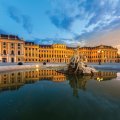A former hunting lodge transformed into a summer palace by the Habsburgs, with sumptuous gardens and sumptuous apartments.
One of Vienna's jewels, with its bright formal gardens with marvellous views, Versailles austerity outside and imperial opulence in the apartments. This summer palace, commissioned at the end of the 16th century by Leopold I, is only three metro stations from the centre. A visit to the apartments is dazzling in its splendour, with styles that are very distinct between the periods of Maria Theresa and Sissi. In fine weather, the carefully designed and impeccably tended gardens are an imperative and imperial walk. For a quiet and complete visit, an afternoon should be planned, preferably during the week to avoid large crowds.
In 1569, the Habsburgs acquired a hunting lodge here with the entire surrounding wooded area. Destroyed by the Turks in 1683, the pavilion was rebuilt in 1695 by the architect Johann Bernhard Fischer von Erlach, as a residence for the heir of Joseph I. It was not until 1711 that the first version of the castle was completed. In 1741, Maria Theresa ordered its extension in order to increase the prestige of the Habsburgs throughout the world. The castle was first used as a summer residence and later became an imperial residence. In 1996, the castle was included in the UNESCO World Heritage List.
Inside, the rococo style dominates. Bohemian crystal chandeliers and the use of numerous mirrors give the Hall of Mirrors a great clarity. It is in the Hall of Mirrors, next door, that Mozart, aged 6, performed for the first time in front of the Emperor. In addition to the interiors and gardens, there are a number of other points of the visit to the complex :
The Imperial Rooms and Apartments: a very interesting 1 hour 10 minute tour (the audioguide is very well done) that allows you to get into the daily life of Maria Theresa, her great-great-grandson Franz Joseph and, of course, the unmissable Elisabeth, known as Sissi. Rooms, kitchens, bathrooms, lose yourself in the imperial apartments and other salons, taking yourself for a guest of the Court. You will also see the Chinese salons with their black lacquer finishes. Round and oval in shape, influenced by the oriental art that Maria Theresa loved, they were the scene of important political events. Minutity and preciousness are not empty words here. Napoleon's study can also be visited, as he made Schönbrunn his headquarters twice during the Austrian campaigns of 1805 and 1809. The palace was also the scene of the tragic end of the Eaglet. The ceiling frescoes are largely the work of Gregorio Guglielmi.
The Gloriette commemorates Maria Theresa's victory over Frederick II's Prussia. It houses an authentic Viennese café. The magnificent view of the castle and the city is not the least of the pleasures of the place, which is especially popular in the summer, where one can treat oneself to a musical meal. A small glass of sparkling white wine after the climb up the park is a real treat!
Imperial Coach Museum (Kaiserliche Wagenburg): the major piece in this collection of armchairs, sleighs and other means of transport of the imperial court is Maria Theresa's coach. A Baroque masterpiece that required eight horses to pull it.
The Children's Museum: dedicated to the youngest (4-12 years old), it retraces the daily life of the imperial family.
Crown Prince's Garden (Kronprinzengarten): this formal garden was used as a private garden for the imperial family. You will appreciate the intricate patterns of the flowerbeds.
The Orangery: the Orangery is the venue for the superb Schönbrunn Palace Concerts (Schloss Schönbrunn Konzerte) where Mozart and Strauss are honoured every evening. The long building with large windows houses the puppet theatre at the end on the palace side.
The Labyrinth: discover this recreation area reconstructed according to the historical model, a playful place of relaxation for young and old. The play stations invite you to try them out.
The Palmeraie: it is superb, open every day from 9.30 am to 6 pm, from May to September, and until 5 pm the rest of the year. It was erected at the request of Franz Joseph and today features palm trees and tropical plants.
The Desert House: opposite the palm grove, it houses plants and animals from the deserts of the world. A visit to be undertaken after that of the palm grove for a small but very amusing climate change.
Tiergarten: this extraordinary zoo in terms of both the animals housed and its structure is the oldest zoo in the world. 700 animal species, from panda to polar bear, share a huge space opposite the palm grove.
Please note that access to Schönbrunn Palace Park is free of charge. Many Viennese come here to walk or jog at the weekend.
Did you know? This review was written by our professional authors.
Book the Best Activities with Get Your Guide
Members' reviews on SCHÖNBRUNN PALACE
The ratings and reviews below reflect the subjective opinions of members and not the opinion of The Little Witty.
Find unique Stay Offers with our Partners




Vaut le détour car c'est un immanquable de la ville de Vienne.